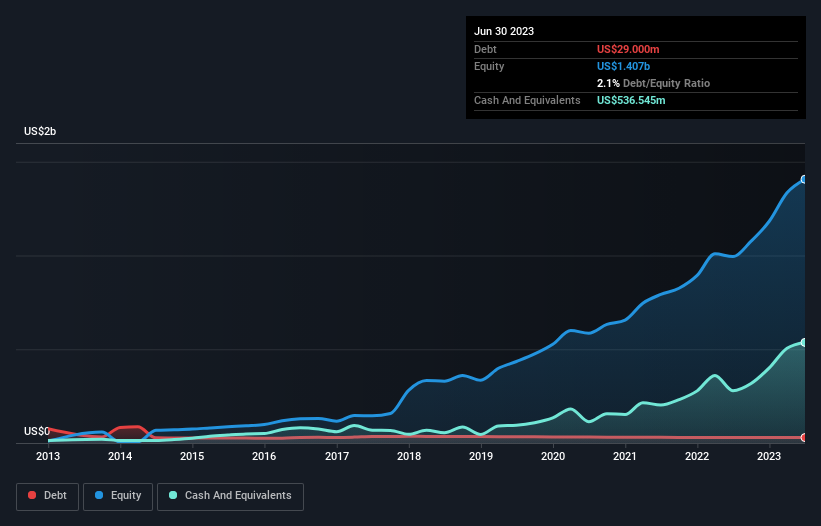- United States
- /
- Professional Services
- /
- NYSE:PAYC
Does Paycom Software (NYSE:PAYC) Have A Healthy Balance Sheet?

Legendary fund manager Li Lu (who Charlie Munger backed) once said, 'The biggest investment risk is not the volatility of prices, but whether you will suffer a permanent loss of capital.' So it seems the smart money knows that debt - which is usually involved in bankruptcies - is a very important factor, when you assess how risky a company is. We can see that Paycom Software, Inc. (NYSE:PAYC) does use debt in its business. But should shareholders be worried about its use of debt?
Why Does Debt Bring Risk?
Debt is a tool to help businesses grow, but if a business is incapable of paying off its lenders, then it exists at their mercy. In the worst case scenario, a company can go bankrupt if it cannot pay its creditors. While that is not too common, we often do see indebted companies permanently diluting shareholders because lenders force them to raise capital at a distressed price. Of course, plenty of companies use debt to fund growth, without any negative consequences. When we think about a company's use of debt, we first look at cash and debt together.
Check out our latest analysis for Paycom Software
How Much Debt Does Paycom Software Carry?
As you can see below, Paycom Software had US$29.0m of debt, at June 2023, which is about the same as the year before. You can click the chart for greater detail. However, its balance sheet shows it holds US$536.5m in cash, so it actually has US$507.5m net cash.

How Healthy Is Paycom Software's Balance Sheet?
The latest balance sheet data shows that Paycom Software had liabilities of US$2.19b due within a year, and liabilities of US$357.9m falling due after that. Offsetting these obligations, it had cash of US$536.5m as well as receivables valued at US$18.1m due within 12 months. So its liabilities outweigh the sum of its cash and (near-term) receivables by US$1.99b.
Since publicly traded Paycom Software shares are worth a very impressive total of US$15.0b, it seems unlikely that this level of liabilities would be a major threat. Having said that, it's clear that we should continue to monitor its balance sheet, lest it change for the worse. While it does have liabilities worth noting, Paycom Software also has more cash than debt, so we're pretty confident it can manage its debt safely.
On top of that, Paycom Software grew its EBIT by 38% over the last twelve months, and that growth will make it easier to handle its debt. The balance sheet is clearly the area to focus on when you are analysing debt. But ultimately the future profitability of the business will decide if Paycom Software can strengthen its balance sheet over time. So if you're focused on the future you can check out this free report showing analyst profit forecasts.
Finally, while the tax-man may adore accounting profits, lenders only accept cold hard cash. Paycom Software may have net cash on the balance sheet, but it is still interesting to look at how well the business converts its earnings before interest and tax (EBIT) to free cash flow, because that will influence both its need for, and its capacity to manage debt. During the last three years, Paycom Software produced sturdy free cash flow equating to 70% of its EBIT, about what we'd expect. This cold hard cash means it can reduce its debt when it wants to.
Summing Up
While Paycom Software does have more liabilities than liquid assets, it also has net cash of US$507.5m. And it impressed us with its EBIT growth of 38% over the last year. So is Paycom Software's debt a risk? It doesn't seem so to us. Over time, share prices tend to follow earnings per share, so if you're interested in Paycom Software, you may well want to click here to check an interactive graph of its earnings per share history.
At the end of the day, it's often better to focus on companies that are free from net debt. You can access our special list of such companies (all with a track record of profit growth). It's free.
New: Manage All Your Stock Portfolios in One Place
We've created the ultimate portfolio companion for stock investors, and it's free.
• Connect an unlimited number of Portfolios and see your total in one currency
• Be alerted to new Warning Signs or Risks via email or mobile
• Track the Fair Value of your stocks
Have feedback on this article? Concerned about the content? Get in touch with us directly. Alternatively, email editorial-team (at) simplywallst.com.
This article by Simply Wall St is general in nature. We provide commentary based on historical data and analyst forecasts only using an unbiased methodology and our articles are not intended to be financial advice. It does not constitute a recommendation to buy or sell any stock, and does not take account of your objectives, or your financial situation. We aim to bring you long-term focused analysis driven by fundamental data. Note that our analysis may not factor in the latest price-sensitive company announcements or qualitative material. Simply Wall St has no position in any stocks mentioned.
About NYSE:PAYC
Paycom Software
Provides cloud-based human capital management (HCM) solution delivered as software-as-a-service for small to mid-sized companies in the United States.
Flawless balance sheet with limited growth.
Similar Companies
Market Insights
Community Narratives



